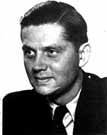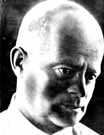
|
|
|

|

|

|

|
|
Click on an image to see a larger, more detailed picture.
|
|
|
|
|
| 1944: Desperate Acts |

|
pg. 520 |

|
|
|
|
| |
 Holding their baby, a young Jewish couple in North Africa prepares to board the ship that will take them to a new life in Palestine. From various points of origin, including Portugal, ships organized by Jewish rescue agencies took Jews from North Africa to Palestine. Yet, even with the arrival of American troops, Jews in places such as Casablanca, Morocco, continued to experience arrest and abuse, sometimes at the hands of right-wing and antisemitic French authorities.
Holding their baby, a young Jewish couple in North Africa prepares to board the ship that will take them to a new life in Palestine. From various points of origin, including Portugal, ships organized by Jewish rescue agencies took Jews from North Africa to Palestine. Yet, even with the arrival of American troops, Jews in places such as Casablanca, Morocco, continued to experience arrest and abuse, sometimes at the hands of right-wing and antisemitic French authorities.
Photo: American Jewish Joint Distribution Committee/United States Holocaust Memorial Museum Photo Archive
|
 Walter Schellenberg achieved new prominence and power in 1944 as head of the combined SS and Wehrmacht security services. His appointment followed the dissolution of the Abwehr and the arrest of its leader, Admiral Wilhelm Canaris. A one-time aide to Heinrich Himmler, Schellenberg performed various responsibilities throughout the war, including leading RSHA Amt VI, which was responsible for intelligence gathering in foreign countries. His new appointment in 1944 placed him second in command only to Himmler within the SS.
Walter Schellenberg achieved new prominence and power in 1944 as head of the combined SS and Wehrmacht security services. His appointment followed the dissolution of the Abwehr and the arrest of its leader, Admiral Wilhelm Canaris. A one-time aide to Heinrich Himmler, Schellenberg performed various responsibilities throughout the war, including leading RSHA Amt VI, which was responsible for intelligence gathering in foreign countries. His new appointment in 1944 placed him second in command only to Himmler within the SS.
Photo: Berlin Document Center / United States Holocaust Memorial Museum Photo Archive
|
 Itzhak Katzenelson
Itzhak Katzenelson
Among those killed in the gas chambers of Auschwitz in the spring of 1944 were poet Itzhak Katzenelson and his 18-year-old son, Zvi. In happier days in Poland, Katzenelson had been a prolific writer in both Yiddish and Hebrew in several genres, from theatrical comedies to children's books. Under the German occupation, first in Lódz, Poland, and then in Warsaw, Katzenelson rallied the ghetto community through works that expressed tenacity in the face of overwhelming hardship, including the deportation of his own wife and two of his children to Treblinka. During the Warsaw Ghetto uprising, Katzenelson and his son, protected by forged Honduran documents, were sent to the Vittel concentration camp in France as part of a proposed prisoner exchange with the Allies. The horror Katzenelson had witnessed compelled him to keep writing. In his diary he testified to the courage of the ghetto deportees and the heroism of the Warsaw Ghetto fighters. His poems from Vittel express the wrenching premonition that the exchange would fail and he and his son would perish. In "The Song of the Murdered Jewish People," Katzenelson agonizes: "Such blessed harvest at one stroke--a people gathered in entire." Katzenelson died with his son at German hands in April 1944.
Photo: Yad Vashem / United States Holocaust Memorial Museum Photo Archive
|
|

|

|

|

|
 April 4, 1944: The first United States air-reconnaissance photos of Auschwitz are taken.
April 4, 1944: The first United States air-reconnaissance photos of Auschwitz are taken.
|
 April 5, 1944: Of 835 Jews deported from Fossoli, Italy, to Auschwitz, 692 are gassed on arrival. Victims include 71-year-old Sara Klein and five-year-old Rosetta Scaramella.
April 5, 1944: Of 835 Jews deported from Fossoli, Italy, to Auschwitz, 692 are gassed on arrival. Victims include 71-year-old Sara Klein and five-year-old Rosetta Scaramella.
|
 April 6, 1944: Three thousand German troops fan out across the "Aryan" section of Warsaw, Poland, to root out fugitive Jews. Seventy men and 30 women are arrested and will be murdered.
April 6, 1944: Three thousand German troops fan out across the "Aryan" section of Warsaw, Poland, to root out fugitive Jews. Seventy men and 30 women are arrested and will be murdered.
|
 April 6, 1944: A Gestapo unit headed by Klaus Barbie searches the Children's Home at Izieu, France, near the Swiss border, and arrests ten nurses and 43 Jewish children. Most are transported to Drancy, France, and then to Auschwitz. One of the children taken to Auschwitz, 11-year-old Liliane Berenstein, writes a letter to God in which she pleads for the return of her parents.
April 6, 1944: A Gestapo unit headed by Klaus Barbie searches the Children's Home at Izieu, France, near the Swiss border, and arrests ten nurses and 43 Jewish children. Most are transported to Drancy, France, and then to Auschwitz. One of the children taken to Auschwitz, 11-year-old Liliane Berenstein, writes a letter to God in which she pleads for the return of her parents.
|
|
|
|
|
| 1944: Desperate Acts |

|
pg. 520 |

|
|
The Holocaust Chronicle
© 2009 Publications International, Ltd.
|
|
